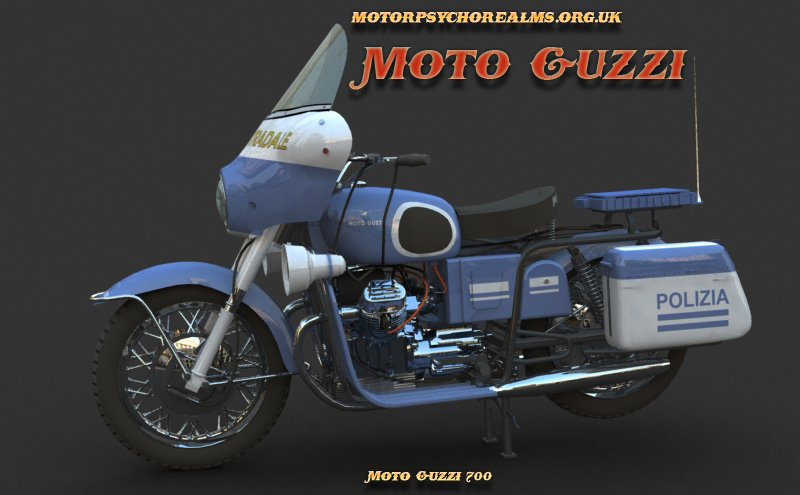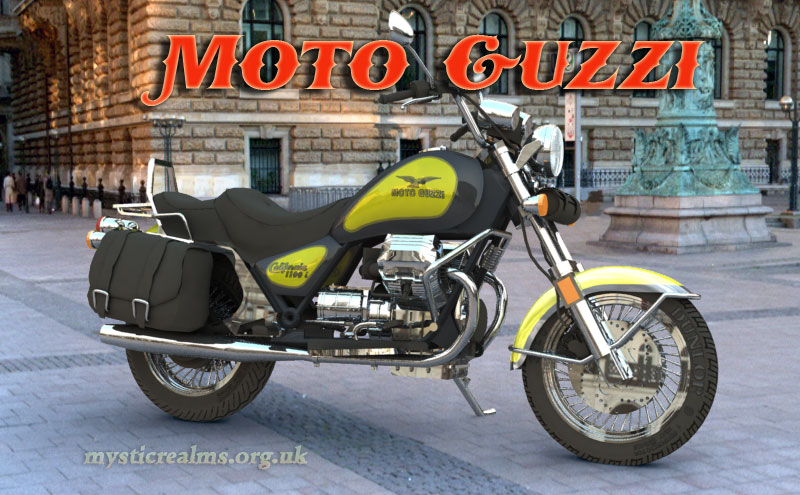Moto Guzzi Motorcycles

Moto Guzzi is an Italian motorcycle manufacturer established in 1921 in Mandello del Lario by Lake Como in Lombardy, producing the "official motorcycle of Italy".
The company currently specializes in transversely-mounted 90? V-twin engines. Moto Guzzi innovations include the cartridge front fork and the patented Compact Reactive Drive Shaft system, which emulates BMW's Paralever. They were also the first motorcycle to develop and produce the "swing arm" rear suspension. Moto Guzzi machines have been used by police forces in Italy, Argentina and the United States. They are known world wide for their reliability and their bullet proof motors. Percentage wise, there are more Moto Guzzis having 100,000 miles or more still in use throughtout the world, than any other brand of motorcycle
From the 1930s until the 1960s, Moto Guzzi was the largest marque amongst Italian motorcycle manufacturers. Carlo Guzzi's (engineer and co-founder) first engine design was a horizontal single, that in a number of guises dominated the first 45 years of the company's history. From the beginning the company used racing to promote their brand. Moto Guzzi won 3,329 official races, 8 World Championships, 6 Constructor's Championships and 11 Isle of Man TT victories.
Until the mid 1940s, the traditional horizontal four-stroke single cylinder 500 cc engines outfitted with one overhead and one side valve (also known as: IOE, inlet over exhaust or F-head) were the most performance oriented machines that Moto Guzzi sold to the general public. At the same time the official racing team and private racers were furnished with all sorts of racing machines which included a plethora of overhead cam, multiple valve configurations and cylinder designs. In the 1935 Isle of Man TT, Moto Guzzi factory rider Stanley Woods performed an impressive double victory with wins in the Lightweight TT as well as the Senior TT.
In the 1950s, Moto Guzzi made an impact in the world of Grand Prix motorcycle racing. With durable and lightweight 250 cc and 350 cc bikes designed by Giulio Carcano, the firm dominated the middleweight classes. The factory won five consecutive 350 cc world championships between 1953 and 1957. Carcano realized that low weight alone couldn't continue to win races so he designed one of the most complex race bikes of the 1950s, the V8 500cc GP race bike. The bike led many races and frequently posted the fastest lap time but, just as frequently broke down before the end of the race. The V8 was never fully developed, because Moto Guzzi decided (together with the main competitors Gilera and Mondial) to pull out of racing after the 1957 season, citing escalating costs and diminishing motorcycle sales.
The period after World War II was as difficult in Mandello del Lario as it was elsewhere in post-war Europe. The solution was production of cheap lightweights. The '46 "Motoleggera", a 65 cc lightweight motorcycle became hugely popular in post-war Italy. A four-stroke 175 cc scooter known as the "Galletto" was a stable seller as well. Though modest for Guzzis, these, and all other models were relatively upmarket and high quality in their corner of the market.
Historically, much of Moto Guzzi's production has gone to the Italian army and police.
In addition, Moto Guzzis were also adopted by various American police departments, challenging the niche market dominance of Harley Davidson. The horizontal single, and from the seventies the V2, has been the official motorcycle of Italy.
The company currently specializes in 90? V-twin engines. The original V-twin was designed in the early 1960s by engineer Giulio Cesare Carcano, designer of the V8 Grand Prix racer. The air-cooled, in-line V-twin, pushrod engine started out with 700 cc displacement and 45 hp, (in-line refers to the crankshaft). This engine was designed to win a competition for a new police bike sponsored by the Italian government. The sturdy shaft drive V-twin easily won and saved the firm from extinction. This 1967 Moto Guzzi V7 with the original Carcano engine has been continuously developed into the 1200 cc 80 hp versions offered today (2006). Lino Tonti did a redesign of the motor for the 1971 Moto Guzzi V7 Sport. This engine is the basis of the currently used 850 cc, 1100 cc and 1200 cc Guzzi engines. The longitudinal orientation of the engine creates a slight gyroscope effect, so when taking left-hand turns the motorcycle will tend to run wider than expected.

MotoGuzzi California
A 4 valve version of the Carcano engine was created in the early '90s and is currently used in the 1250 cc MGS-01 Corsa.
In 1979 a small block version designed by engineer Lino Tonti was introduced as the V35. This design was the basis of a development that later brought the 750 Breva and Nevada engines. It was quite radical, cutting the weight from the 548 lb of the contemporary 850 T3 to the 385 lb of the V35. The horsepower of the original V35 (35 bhp) was similar to that of other engines of comparable displacement of the period, but the later developed bigger versions (V50, V65, V75) were rapidly outclassed by the development of water cooled engines (today the Breva 750 is rated at 48 bhp). However, this linked to a beautifully flat torque curve, and a very easy maintenance and durability of the mechanical parts that makes these bikes eminently useful in 'real world situations'.
Horsepower was increased in the mid '80s when Guzzi created 4 valve versions of the "small block" series. Of these, the 650 and the 750 were rated at 60 and 65 bhp respectively. The production of the 4 valve "small block" engines ended in the later '80s.
Moto Guzzis have used an hydraulic integral brake system, where the right front disc works off the handlebar lever, while the left front and the rear disc work off the foot brake. Rudge-Whitworth used an early integrated, anti-lock, braking system in 1925.
The cartridge front fork used in Guzzi's motorcycles of the later '70s and '80s is a Guzzi invention. Instead of containing the damping oil in the fork it's in a cartridge. Oil in the fork is purely for lubrication.
from Wikipedia licensed under the GNU Free Documentation License

